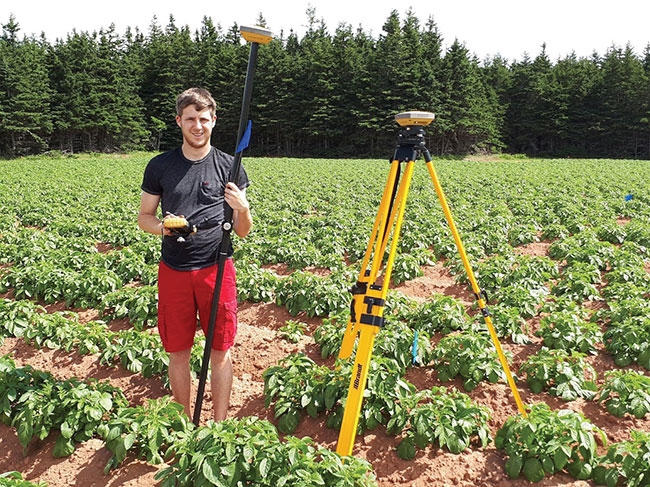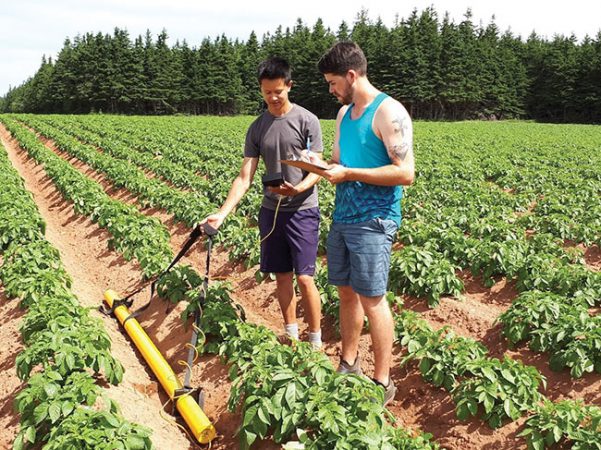
Features
Chemicals
Weed Control
Precision agriculture for potato production
Research is underway to develop technologies and tools for growers in the Maritimes.
March 5, 2019 By Carolyn King
 RTK-GPS is used to map the topography of potato fields Variable-rate applications of crop inputs can offer significant benefits.
RTK-GPS is used to map the topography of potato fields Variable-rate applications of crop inputs can offer significant benefits.Variable-rate applications of crop inputs can offer significant benefits for the crop, the environment and the grower’s bottom line. So Aitazaz Farooque is leading a research program that is tackling the challenge of developing practical systems that accurately determine what inputs to apply, how much to apply and where to apply them for potato production in the Maritimes.
This research involves fertilizer, herbicide and fungicide inputs. “When we apply these inputs based on need [rather than applying them uniformly across a field], we are saving on agrochemicals. And at the same time, we are promoting sustainable agriculture since we are applying fewer chemicals,” explains Farooque, an assistant professor in the faculty of sustainable design engineering at the University of Prince Edward Island.
For instance, applications that provide just enough but not too much fertilizer to meet the crop’s nutrient needs, as those needs vary across a field, would enhance crop performance and reduce fertilizer costs. And such applications would avoid excessive nutrient levels that could increase the risk of nutrient losses to the environment that could degrade water quality and contribute greenhouse gases to the atmosphere.
“The goal of this research program is to develop technologies to characterize and quantify soil and crop variability, and then come up with the tools and options that can do that on the go for effective decision making in a sustainable fashion,” he says. “We want to find out what the needs are, and based on that, we want the decision making to improve profitability and at the same time protect the environment.”
This research program is funded by the Natural Sciences and Engineering Research Council of Canada (NSERC), P.E.I. Potato Board, New Brunswick Department of Agriculture, Aquaculture and Fisheries, Canadian Space Agency, Provincial Government of P.E.I., and other industry partners. The fieldwork is taking place across P.E.I. with sites at O’Leary, Summerside, Hamilton and Souris, and in New Brunswick at Grand Falls and Florenceville.
Having multiple field sites over multiple years helps ensure the systems developed through this research will be able to accommodate the range in variability that could occur within individual fields and between fields, and within a single year and from one year to another. That variability can be due to variations in factors like landscape characteristics, soil characteristics, weather conditions and crop production practices.
Farooque and his research team are working with various sensors and technologies for mapping in-field variations at each site to determine which options would be best for creating prescriptions for variable-rate applications on potato fields.
For instance, they are using ordinary cameras and cameras that capture thermal imagery and multispectral imagery. These cameras are mounted on drones or field equipment, and are used in mapping things like weeds, crop health and disease, and the amount of heat emitted from the soil, which is related to moisture content.
A DUALEM sensor is another important instrument in the research. It measures electrical conductivity (EC) in the ground. “There are different studies on conductivity showing that it is related with soil moisture content, soil nutrients, soil organic matter and sometimes soil texture. So EC is a pretty handy tool,” Farooque notes. The DUALEM sensor can be dragged behind an ATV or a tractor, or it can be dragged by hand for small-plot studies.
As well, the team is evaluating technologies like yield monitors and soil moisture sensors. They are also comparing two different options for elevation and slope mapping: RTK-GPS (real-time kinematics global positioning system) and LIDAR (light detection and ranging). Both RTK and LIDAR can be used to create digital elevation models, which are helpful for things like mapping water flow across a field and for landscapes where topsoil has been eroded from the hilltops and deposited in the low areas.
Each sensor used for precision agriculture research has to be calibrated and validated for the conditions at each site. For example, the research team has to do detailed soil sampling across each field site to find out how the DUALEM data is correlated with the results from the lab analysis of the soil samples, like soil organic matter content and soil nutrient levels. They have to measure the greenness of leaf samples to see how that correlates with the imagery from the cameras; they have to compare the yield monitor data with the actual yield data; and so on.
Farooque and his team overlay the maps produced by all the different sensors and analyze how well the different layers match up with each other, and they determine which layers are the most significant ones for potato production in that particular field. Farooque says, “There are always some variables that don’t affect things as much as the others do. It really depends on the situation.” This analysis enables the team to identify management zones in the field that can then be used to guide the variable-rate control system for applying the inputs.
They are also conducting studies to figure out the appropriate rates for the nutrient inputs in each management zone. The main focus of this work involves determining optimal variable-rate applications for commercial fertilizer blends of nitrogen, phosphorus and potassium. In 2019, they will be doing small-plot experiments to assess the effects of these applications on potato yields and greenhouse gas emissions. Then in 2020, they will be evaluating the effects in field-scale experiments.
In addition, they are conducting micronutrient studies, and they will be doing an experiment in 2019 to compare slow-release nitrogen fertilizer with nitrogen fertilizer split into three applications over the growing season. They are also exploring the possibility of applying biosolids amendments. For instance, in a 2017 experiment, they applied biochar to see if it might improve potato productivity, enhance soil organic matter content, and increase carbon storage. Biochar is a soil amendment made through a combustion process that turns biological products – in this case wood chips and fish waste – into charcoal.
Farooque and his team are only two years into this innovative research program, but they are making progress. One key step forward is that they already have a good sense of how to manage nutrients based on the conductivity measurements.
Another important step is that they are in the process of developing a sensor that is using deep learning (a type of machine learning) to identify patches of weeds and diseased potato plants. Once the sensor has completely mastered this learning, it could be used for on-the-go targeted spraying. So, the sensor would detect plants that need to be sprayed as the operator drives through the field, and in real time, the sensor would send instructions to sprayer’s control system, which would emit the spray from the appropriate nozzles.
The results from Farooque’s research could help potato growers to make more efficient, targeted input applications that improve productivity and reduce environmental risks. Within a few years, he expects to have some technologies and tools developed, and to have them tested and evaluated at the growers’ level.
Farooque says, “At the end of the day, the idea is to work with the potato industry to solve the problems they are facing and to help the industry to be more profitable and sustainable.”
Print this page
